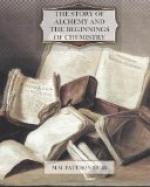[4] The author I am quoting had said—“Nature is divided into four ‘places’ in which she brings forth all things that appear and that are in the shade; and according to the good or bad quality of the ‘place,’ she brings forth good or bad things.... It is most important for us to know her ‘places’ ... in order that we may join things together according to Nature.”
CHAPTER V.
THE ALCHEMICAL ESSENCE.
In the last chapter I tried to describe the alchemical view of the interdependence of different substances. Taking for granted the tripartite nature of man, the co-existence in him of body, soul, and spirit (no one of which was defined), the alchemists concluded that all things are formed as man is formed; that in everything there is a specific bodily form, some portion of soul, and a dash of spirit. I considered the term soul to be the alchemical name for the properties common to a class of substances, and the term spirit to mean the property which was thought by the alchemists to be common to all things.
The alchemists considered it possible to arrange all substances in four general classes, the marks whereof were expressed by the terms hot, cold, moist, and dry; they thought of these properties as typified by what they called the four Elements—fire, air, water, and earth. Everything, they taught, was produced from the four Elements, not immediately, but through the mediation of the three Principles—mercury, sulphur, and salt. These Principles were regarded as the tools put into the hands of him who desired to effect the transmutation of one substance into another. The Principles were not thought of as definite substances, nor as properties of this or that specified substance; they were considered to be the characteristic properties of large classes of substances.




